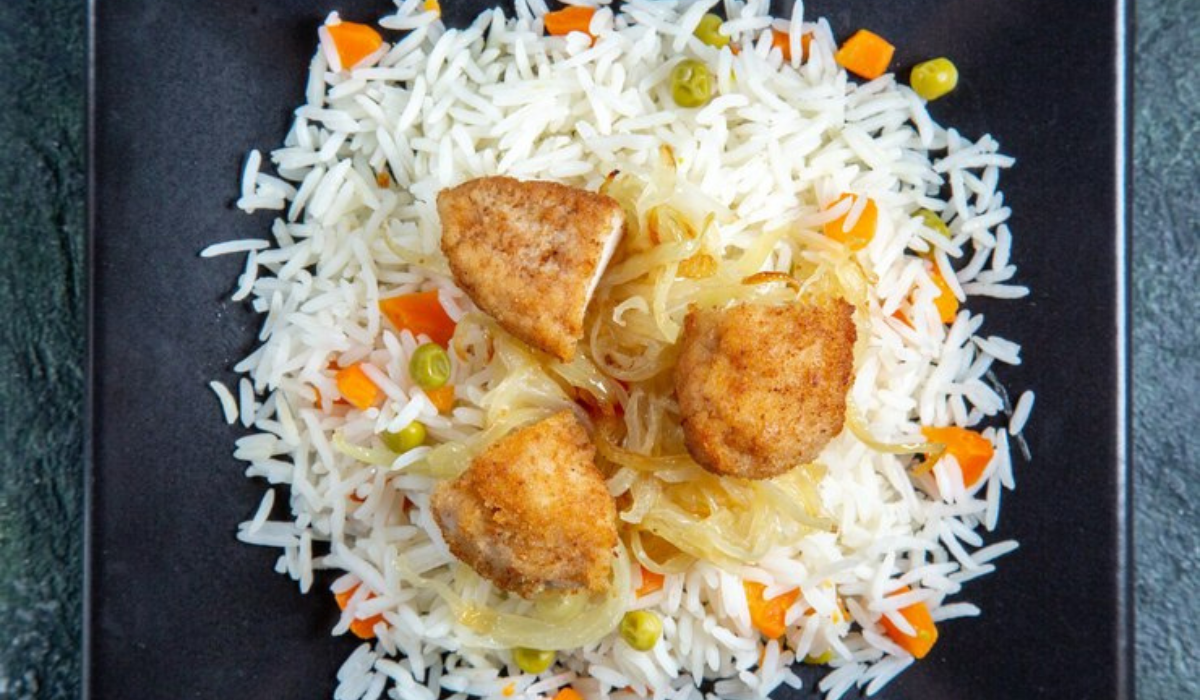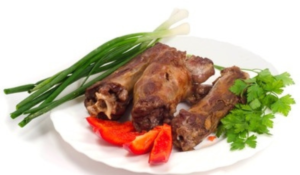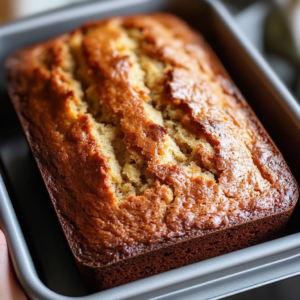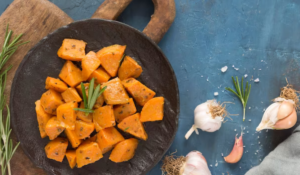Sharing is caring!
Table of Contents
ToggleIntroduction to Chicken Over Rice: A Culinary Staple Across Cultures
Chicken Over Rice isn’t just a dish; it’s a culinary phenomenon. This simple, yet versatile meal has found its way into the hearts and kitchens of people worldwide, transcending cultural and geographic boundaries. Originating from humble beginnings, Chicken Over Rice has evolved into a global favorite, known for its comforting warmth and adaptable nature.
At its core, Chicken Over Rice is the harmonious blend of tender, seasoned chicken and perfectly cooked rice. Each region adds its unique twist, making the dish a mirror of local flavors and traditions. From the aromatic spices in the Middle East to the savory sauces of Asia, Chicken Over Rice adapts to suit every palate.
This dish is more than just food; it’s a story of migration, adaptation, and culinary innovation. As people moved and cultures mingled, Chicken Over Rice became a canvas for culinary creativity, absorbing influences and ingredients, making it a symbol of culinary unity.
In this guide, we dive deep into the world of Chicken Over Rice. We explore its rich history, the variety of its forms, and its significance in different cultures. Whether you’re a food enthusiast, a home cook, or simply someone who appreciates a good meal, this journey through the flavors and stories of Chicken Over Rice is sure to enrich your understanding and love for this timeless dish.
What is Chicken Over Rice?
Chicken Over Rice is a globally cherished dish, epitomizing the perfect fusion of simplicity and flavor. At its core, it combines succulent, seasoned chicken with a bed of fluffy rice, each bite offering a taste of comfort and homeliness. This dish stands as a testament to culinary simplicity, proving that a few basic ingredients can create a meal rich in taste and satisfaction.
Originating from diverse cultural backgrounds, Chicken Over Rice has adapted to various palates, integrating local flavors and ingredients. In some regions, it’s a symphony of spices and herbs, while in others, it’s the subtle blend of sauces and marinades that elevates the chicken’s natural flavor. The rice, often seen as a simple side, plays a crucial role, absorbing the juices and essence of the chicken, making every spoonful a delightful experience.
This dish goes beyond being just a meal; it’s a culinary staple that resonates with people from all walks of life. Whether it’s a quick lunch in a bustling city or a comforting dinner at home, Chicken Over Rice fits every occasion. Its versatility lies in its simplicity – it’s as fitting for a weekday meal as it is for a festive gathering.
In essence, Chicken Over Rice is more than the sum of its parts. It’s a dish that has journeyed across borders, adapted within various culinary traditions, and found a place in the hearts of millions. As we explore its variations and origins, we uncover a story of culinary unity, a dish that brings people together, one plate at a time.
Ingredients
The beauty of Chicken Over Rice lies in its simplicity, anchored by key ingredients that bring the dish to life. Central to this culinary classic are two main components: chicken and rice. The choice of chicken, whether breast, thigh, or whole, dictates the texture and richness of the dish. Marinating the chicken in a blend of spices, herbs, and sometimes yogurt, ensures a flavorful and juicy result that perfectly complements the rice.
The rice, often long-grain varieties like Basmati or Jasmine, serves as the dish’s foundation. It absorbs the flavors from the chicken and any added spices, transforming into a fragrant and fluffy bed that elevates the overall taste. Cooking the rice in a broth or with added aromatics like garlic, onions, or bay leaves can further enhance its flavor.
Variations of Chicken Over Rice often include a range of vegetables, such as bell peppers, onions, or peas, adding color, texture, and nutritional value. For a richer experience, some recipes incorporate nuts like almonds or cashews, offering a delightful crunch.
Sauces and condiments also play a crucial role in Chicken Over Rice. From the creamy, tangy yogurt-based sauces in Middle Eastern versions to the spicy, savory sauces in Asian renditions, these additions allow for personalization and can dramatically change the dish’s character.
Lastly, garnishes like fresh herbs, lemon wedges, or a sprinkle of spices add a final touch of freshness and visual appeal, making Chicken Over Rice not just a meal, but a feast for the senses. This dish, with its humble ingredients, is a canvas for creativity, allowing each cook to imprint their personal culinary signature.
Nutritional Value of Chicken Over Rice
Chicken Over Rice is not just a feast for the taste buds; it’s also a wellspring of nutritional value. This dish, when prepared thoughtfully, strikes a balance between protein, carbohydrates, and fats, making it a wholesome choice for a meal.
The chicken, being the protein powerhouse of the dish, offers essential amino acids necessary for muscle growth and repair. Opting for leaner cuts like breast reduces the fat content, while darker cuts like thigh provide more iron and flavor. The way you cook the chicken – grilled, roasted, or stewed – also impacts its nutritional profile, with grilling being a healthier option to retain nutrients without adding extra fat.
Rice, the dish’s carbohydrate component, provides energy and fiber, especially when using whole grain varieties. Brown or wild rice, for instance, offers more fiber, vitamins, and minerals compared to white rice, aiding in better digestion and sustained energy release.
Vegetables, often added to Chicken Over Rice, contribute vitamins, minerals, and fiber. Bell peppers, for instance, are high in vitamin C, while peas offer a good source of iron and magnesium. The inclusion of these vegetables not only enhances the dish’s flavor but also boosts its nutritional content.
Sauces and condiments, while adding zest to the dish, should be used judiciously. Yogurt-based sauces can provide calcium and probiotics, while spicy or savory sauces can add sodium. Moderation is key to keeping the dish healthy.
In conclusion, the nutritional value of Chicken Over Rice is a dynamic aspect that depends largely on the choice of ingredients and preparation methods. By making mindful choices, this dish can serve as a nutritious meal that supports overall health, offering a balance of macronutrients and essential micronutrients, while still being a delightful culinary experience.
Cooking Techniques
Mastering Chicken Over Rice involves understanding various cooking techniques that enhance the flavors and textures of this beloved dish. The key to its success lies in how you cook both the chicken and the rice to achieve a harmonious blend of flavors.
For the chicken, marinating is the first step to infuse it with flavors. A blend of spices, herbs, and sometimes yogurt or citrus juices can tenderize and flavor the meat. The cooking method varies – you can grill the chicken to achieve a smoky flavor, roast it for a more even, golden-brown crust, or sauté it for a quick and flavorful option. The goal is to cook the chicken until it’s juicy and tender, with a richly flavored exterior.
When it comes to the rice, the absorption method is a popular technique. This involves cooking the rice in a measured amount of broth or water, which it fully absorbs, resulting in fluffy, separate grains. The rice can also be sautéed with onions or garlic before adding the liquid to enhance its flavor. Some recipes call for layering the cooked chicken over the rice and allowing them to finish cooking together, enabling the rice to absorb the chicken’s juices.
Another technique is to cook the chicken and rice together, often used in one-pot versions of Chicken Over Rice. This method allows the flavors to meld together, with the rice absorbing the chicken’s juices as they both cook.
For a crispy texture, some prefer to finish the dish in the oven. This step crisps up the chicken’s skin and gives the rice a slightly toasted flavor, adding a delightful textural contrast.
In summary, the cooking techniques for Chicken Over Rice range from marinating and grilling to sautéing and baking. Each method contributes to the dish’s overall flavor and texture, making Chicken Over Rice a versatile and satisfying meal.
Chicken Over Rice in Different Cultures
Chicken Over Rice is a culinary chameleon, adapting to the tastes and traditions of various cultures around the world. Each region imprints its unique signature on this versatile dish, making it a testament to the diversity of global cuisines.
In the Middle East, Chicken Over Rice often features a rich blend of spices like cumin, coriander, and cardamom. The chicken, usually slow-cooked or grilled, is tender and aromatic, paired with rice cooked in a fragrant broth. Toppings like nuts, raisins, or fresh herbs add texture and a burst of flavor.
Moving to Asia, particularly in regions like Southeast Asia and South Asia, Chicken Over Rice takes on a different character. Here, it’s common to find the dish served with a spicy sauce or marinated in a savory blend of soy sauce, ginger, and garlic. The rice, often sticky or jasmine, complements the bold flavors of the chicken.
In the United States, Chicken Over Rice has become a street food staple, especially in cities like New York. The American version typically features grilled or rotisserie chicken over a bed of yellow rice, often accompanied by a mild white sauce or a spicy red sauce.
The Latin American variation includes ingredients like bell peppers, tomatoes, and onions, with the chicken often cooked in a flavorful tomato-based sauce. This version is vibrant, both in color and taste, reflecting the lively culinary spirit of the region.
In Europe, particularly in countries like Greece, Chicken Over Rice often includes Mediterranean influences such as olives, lemon, and oregano, with the chicken often grilled to perfection.
Each culture’s take on Chicken Over Rice tells a story of local ingredients, cooking methods, and traditional flavors. This dish, in its many forms, not only satisfies the palate but also offers a glimpse into the culinary soul of each culture it represents.
Pairing with Side Dishes
When it comes to elevating Chicken Over Rice, the right side dishes can transform it into a complete, well-rounded meal. The key is to choose accompaniments that complement the flavors of the chicken and rice, while adding variety in texture and nutrition.
A classic pairing is a fresh salad, such as a crisp green salad or a tangy coleslaw. The freshness and crunch of the salad provide a delightful contrast to the savory, tender chicken and soft rice. For a Mediterranean twist, a Greek salad with olives and feta cheese can be a flavorful addition.
Steamed or roasted vegetables are another excellent choice. Options like broccoli, carrots, or a medley of seasonal vegetables not only add color and nutrients to the meal but also offer a subtle flavor that doesn’t overpower the main dish. Drizzling these vegetables with a light dressing or a squeeze of lemon can enhance their taste.
For a heartier accompaniment, consider legumes like lentils or chickpeas. These can be served as a side salad, spiced and dressed to match the flavor profile of the Chicken Over Rice, or even as a warm, comforting stew.
If you’re looking to add a creamy element, a side of yogurt or a yogurt-based dip can be a great addition, especially for spicier versions of Chicken Over Rice. The cool, tangy yogurt balances the heat and adds a smooth texture to the meal.
Bread, such as pita or naan, can also be served alongside Chicken Over Rice. It’s perfect for scooping up rice and sauce, making the meal more satisfying and interactive.
In summary, the ideal side dishes for Chicken Over Rice should complement the main dish’s flavors and textures while adding their own unique touch. From fresh salads to steamed vegetables and creamy dips, the possibilities are endless, allowing you to create a meal that’s both delicious and nutritionally balanced.
Vegetarian and Vegan Alternatives :
Creating vegetarian and vegan alternatives for Chicken Over Rice is a delightful exploration of flavors and ingredients. The goal is to maintain the essence of the dish while replacing chicken with plant-based options that provide a similar texture and richness.
Tofu stands out as a popular alternative, especially when marinated and cooked to mimic the savory flavors of chicken. Extra-firm tofu, when pressed and seasoned with spices or soy-based marinades, can be grilled, baked, or sautéed, offering a satisfying texture and taste that pairs well with rice.
Seitan, a wheat gluten-based protein, is another excellent choice for a chicken substitute in Chicken Over Rice. Its meat-like texture and ability to absorb flavors make it ideal for recreating the dish. Seitan can be chopped, seasoned, and cooked in a way that closely resembles the original chicken preparation.
For a whole-food approach, mushrooms, particularly portobellos or shiitakes, provide a meaty texture and umami flavor. Sliced and sautéed with garlic, herbs, and a touch of soy sauce, they make a flavorful and nutritious stand-in for chicken.
Legumes like chickpeas or black beans are also great options. They bring protein and fiber to the dish, and when cooked with the right blend of spices, they add a heartiness that satisfies the craving for Chicken Over Rice.
In terms of rice, the same varieties used in the original dish work well in vegetarian and vegan versions. Brown or wild rice can be used for added nutrition, and cooking the rice in vegetable broth enhances its flavor.
Cooking Tips and Tricks :
Perfecting Chicken Over Rice requires a blend of technique and intuition. Here are some tips and tricks to elevate this classic dish to new heights.
First, pay attention to the chicken marinade. A good marinade not only flavors the chicken but also tenderizes it. Use acidic ingredients like lemon juice or yogurt, and let the chicken marinate for at least an hour, or overnight for deeper flavor.
When cooking the chicken, ensure it reaches the perfect doneness – juicy and tender, not dry. If you’re grilling or pan-frying, let the chicken rest for a few minutes after cooking. This step allows the juices to redistribute, ensuring a moist bite every time.
For the rice, rinsing it before cooking is crucial. This step removes excess starch, preventing the rice from becoming sticky. If you’re aiming for fluffy rice, use a ratio of 1 part rice to 1.5 parts water. Bring the rice to a boil, then simmer it covered on low heat until the water is absorbed.
Don’t underestimate the power of seasoning. Apart from salt, incorporate spices and herbs that complement the chicken’s flavor. Spices like cumin, paprika, or turmeric can add depth, while fresh herbs like cilantro or parsley bring a burst of freshness.
Incorporate layers of flavor by cooking the rice in chicken or vegetable broth instead of water. This simple switch infuses the rice with rich, savory notes, making Chicken Over Rice more flavorful.
Lastly, balance the textures. If your chicken is grilled or roasted with a crispy skin, pair it with smooth, creamy rice. If the chicken is softer, like in a stew, opt for rice with a bit of bite, like pilaf.
With these tips and tricks in mind, you can transform your Chicken Over Rice into a dish that’s not only a delight to eat but also a joy to cook.
DIY Chicken Over Rice Recipes
Creating your own Chicken Over Rice recipes allows for culinary creativity and personalization. Here’s a basic framework to craft a delicious DIY version, with room for your unique touches.
1. Choose Your Chicken: Begin with your preferred cut of chicken. For a quicker cook, go for boneless breasts or thighs. If you favor richer flavors, opt for bone-in pieces. Marinate your chicken in a mixture of your choice – think garlic, herbs, spices, and a bit of oil or yogurt. This not only adds flavor but also tenderizes the meat.
2. Prepare the Rice: Select a rice variety that suits your taste – Basmati for fragrance, Jasmine for a softer texture, or brown rice for a nuttier, healthier option. Rinse the rice under cold water until the water runs clear. This step is key to achieving fluffy, non-sticky rice.
3. Cook the Chicken: Heat some oil in a pan and cook the chicken until it’s golden and cooked through. For an extra flavor boost, consider browning the chicken first to develop a rich, caramelized crust.
4. Flavor the Rice: In the same pan, sauté onions and garlic until they’re soft. Add the rice, stirring to coat it in the flavors. Pour in chicken or vegetable broth (or water) and bring it to a boil. Reduce the heat, cover, and let it simmer until the rice is tender.
5. Combine and Garnish: Once both the chicken and rice are cooked, assemble your Chicken Over Rice. You can either lay the chicken on top of the rice or mix them together. Garnish with fresh herbs, a squeeze of lemon, or a drizzle of a simple sauce like a garlic yogurt or a spicy mayo.
Hosting a Chicken Over Rice Dinner
Hosting a dinner centered around Chicken Over Rice can be a delightful and satisfying experience. Here are some tips to ensure your dinner is a hit:
1. Plan Your Menu: Decide on the style of Chicken Over Rice you want to serve. Will it be a spicy Asian-inspired dish or a comforting Middle Eastern rendition? This decision will guide the rest of your menu, from appetizers to desserts.
2. Prepare in Advance: Marinade your chicken a day ahead to save time and enhance flavor. Also, consider preparing some components, like sauces or side salads, earlier in the day.
3. Consider Dietary Preferences: Ensure there are options for guests with dietary restrictions. Offering a vegetarian version of Chicken Over Rice with tofu or mushrooms keeps everyone included.
4. Set the Ambiance: Create a cozy, inviting atmosphere. Light candles, play some background music, and set the table with care. The ambiance plays a big role in making your dinner memorable.
5. Pair with Side Dishes: Complement your Chicken Over Rice with side dishes that balance the meal. Think of a light salad, some steamed vegetables, or a simple soup. These sides shouldn’t overshadow the main dish but rather enhance it.
6. Offer a Variety of Toppings: Set out a range of toppings like chopped herbs, nuts, or a selection of sauces. This allows guests to customize their plate according to their taste preferences.
7. Don’t Forget Beverages: Offer a selection of drinks that pair well with your version of Chicken Over Rice. This could range from wine or beer to refreshing non-alcoholic options like iced tea or flavored water.
8. Enjoy the Moment: Remember, the goal is to enjoy the company and the food. Don’t stress over perfection; the joy of sharing a meal like Chicken Over Rice is in its simplicity and the warmth it brings to the table.
Kids and Chicken Over Rice
Introducing kids to Chicken Over Rice is not only a great way to expand their culinary horizons but also an opportunity to provide them with a nutritious and enjoyable meal. Here are some tips to make Chicken Over Rice more appealing and kid-friendly:
1. Keep It Simple: Children often prefer simpler flavors. Start with a basic recipe for Chicken Over Rice, using mild spices and herbs. Avoid overly spicy or complex flavors that might overwhelm young palates.
2. Involve Them in Cooking: Kids are more likely to eat something they’ve helped make. Involve them in safe and simple steps like rinsing the rice, stirring the pot, or adding pre-measured spices.
3. Make It Colorful: Add vegetables like peas, carrots, or sweet corn to the dish to make it more colorful and nutritious. Kids eat with their eyes first, so the more visually appealing the meal, the better.
4. Focus on Texture: Some kids are sensitive to textures. Ensure the chicken is tender and the rice is fluffy to make the dish more palatable for them. Avoiding overly crispy or chewy components might help.
5. Use Fun Shapes: Consider cutting the chicken into bite-sized pieces or using cookie cutters for fun shapes. This can make Chicken Over Rice more exciting and easier for little ones to eat.
6. Serve with Favorite Sides: Pair Chicken Over Rice with a side dish your kids love, like apple slices, a favorite dip, or a small serving of fries. This can make the new dish more approachable.
7. Encourage Tasting: Encourage kids to try a small portion without pressure. Sometimes, it takes a few exposures to a new dish before they start to enjoy it.
FAQs
Can I make Chicken Over Rice in a slow cooker? Yes, you can prepare Chicken Over Rice in a slow cooker. Start by layering the chicken and seasonings at the bottom, then add your rice and liquid. Cook on low for several hours until the chicken is tender and the rice has absorbed the liquid. This method is great for melding flavors and ensuring tender, juicy chicken.
What type of rice works best for Chicken Over Rice? Long-grain rice like Basmati or Jasmine is ideal for Chicken Over Rice because they yield fluffy, separate grains that absorb flavors well. However, you can use other types of rice like brown rice for a healthier twist, adjusting the cooking time and liquid as needed.
How can I make my Chicken Over Rice more flavorful? Marinate your chicken for several hours or overnight to deepen the flavor. Use a variety of spices and herbs, and consider sautéing the rice in onions, garlic, or spices before adding the liquid. Cooking the rice in chicken or vegetable broth also adds more flavor.
Is Chicken Over Rice healthy? Chicken Over Rice can be a healthy meal option, especially if you use lean cuts of chicken, include plenty of vegetables, and opt for whole-grain rice. Be mindful of the amount of oil and salt used to keep it healthier.
Can I make Chicken Over Rice vegetarian or vegan? Absolutely! Replace the chicken with plant-based proteins like tofu, tempeh, or a mix of hearty vegetables. Use vegetable broth for cooking the rice and ensure any additional sauces or toppings are plant-based.
How can I store and reheat leftovers? Store leftovers in an airtight container in the refrigerator for up to 3 days. Reheat in the microwave or on the stovetop, adding a little water or broth to keep the rice moist. It’s best to avoid reheating the dish multiple times.
Conclusion
In conclusion, Chicken Over Rice is more than just a dish; it’s a culinary journey that connects cultures and flavors from around the globe. Its versatility and simplicity make it a favorite among home cooks and professional chefs alike. Whether you’re preparing a quick weekday dinner or hosting a special gathering, Chicken Over Rice adapts to suit any occasion.
The beauty of this dish lies in its ability to be customized. From the choice of chicken and rice to the blend of spices and accompanying side dishes, every element offers room for creativity and personal touch. For health-conscious individuals, Chicken Over Rice can be tailored to fit dietary preferences, making it a wholesome and nourishing meal.
Moreover, its appeal to all age groups, including kids, makes Chicken Over Rice a family-friendly option that can be enjoyed by everyone. The dish’s ability to incorporate vegetarian and vegan variations ensures that it caters to diverse dietary needs, making it a universal favorite.
As we’ve explored the various aspects of Chicken Over Rice – from its nutritional value to cooking techniques and cultural significance – it’s clear that this dish is much more than the sum of its parts. It represents a fusion of tradition and innovation, a testament to the power of simple ingredients coming together to create something truly special.
So, whether you’re a seasoned cook or a culinary novice, remember that Chicken Over Rice is a canvas for your culinary artistry. Each ingredient, each spice, and each cooking method is a stroke of your brush, creating a masterpiece that’s uniquely yours. Embrace the versatility, enjoy the process, and relish the delicious results of your Chicken Over Rice creation.






